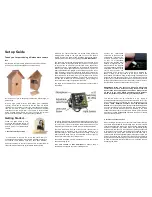
3
L
M
AL
K
M
L
C mount lens
CS mount lens
4.6. Adjustment of Lenses
Adjustment of flange
focus for fixed focus
lenses
This adjustment (distance between lens casing and sensor surface) is required if a sharp
definition cannot be obtained with the lens focussing, or in order to adjust the
∞
position
To obtain a sharp definition, point the camera at an object which is at least 000 times
further away from the front of the lens than the focal length. (If the focal length is 7.5mm,
the object must be at least 5m distant from the camera).
Open the aperture fully and set the focus to
∞
(infinite).
If the lens has automatic exposure control, select a dark object, or better use an ND filter
(64-x) to ensure that the aperture is fully open.
Undo set screw
M
. Turn the lens with the CS mount connection until the definition is sharp.
When finished, retighten screw
M
.
Adjustment of flange
focus for variable
focus lenses
To obtain a sharp definition, point the camera at an object which is at least 5 times the
minimum lens distance (MOD) of the lens. (If this is m, the object must be at least 5m
distant from the camera).
Open the iris fully and set the lens to the maximum tele position and focus with the focus
ring.
If the lens has automatic iris control, select a dark object (or use an ND filter, 64-x)
to ensure that the iris is fully open.
Set the lens to the maximum wide-angle position.
Undo set screw
M
and turn the C/CS ring on the camera until an optimal sharpness is
reached. Repeat the process for checking purposes, if necessary.
When finished, retighten screw
M
.
Note
The value stated in the diagram as
AL
(depth of thread of the lens with CS mount:
<- 5mm) must be observed. The camera may be damaged if this value is exceeded.
When installing a lens with CS mount, never use the C-mount adapter ring.
Addition when using
cameras for day/
night application
Even if the lens is IR corrected (0-focus shift), a minor flange focus is possible between
visible light and IR light.
If there is a day/night application with IR illumination, the flange focus should be set under
IR light conditions. This is because the iris is generally opened when used at night due
to the poor level of light and low depth of focus. During the day, the iris is continuously
closed further, there is a greater depth of focus and the difference in the flange focus is
compensated.














































